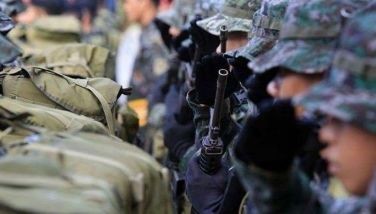Counting machines can prevent poll fraud, says supplier
November 16, 2003 | 12:00am
The automated counting machines (ACMs) that will be used by the Commission on Elections (Comelec) in the May 2004 polls have safety features that can prevent "dagdag-bawas," or vote padding and shaving, operations.
This was assured yesterday by the winning bidder in the Comelec’s automated vote counting and canvassing project to dismiss apprehension on the realibility of the counting machines during the actual elections.
Lawyer Alfredo Lazaro Jr., spokesman for the winning bidder Mega Pacific Consortium (MPC), said the ACMs to be used have optical mark image recognition (OMIR) technology and Microsoft Windows 200-based computer built into one stand-alone system.
"A stand-alone machine has no mouse, keyboard and network connections that it cannot accept input of data from external device," he said, adding that the machine can also withstand power outage with its uninterruptible power supply and can continue running temporarily for 10 minutes, enough to finish processing of a precinct.
Lazaro also said that with the automatic feeding feature of the machine (maximum of 400 ballots per feeding), it reads two-sided ballot in one scanning operation with reading speed of 50 ballots per minute.
The Department of Science and Technology (DOST) has certified that the ACM has 100 percent reading accuracy.
Director Rolando Villoria, in his Oct. 24, 2003 letter to the Comelec, said that "after experiencing the present performance of the ACM, the DOST has no doubt whatsoever, that the ACM can be 100 percent accurate in reading and counting the votes if each voter will do their part in accomplishing the ballots properly."
Meanwhile, Lazaro stressed that the most important feature of the mchine is its ability to detect fake, spurious and recycled or previously read ballot with its magnetic ink character recognition (MICR) coding.
He said that this feature would certainly help prevent "dagdag-bawas" during the actual counting and canvassing of votes.
"It (machine) has separate counted ballot bin and a reject ballot bin," Lazaro further said.
Since the machine is a stand-alone equipment, Lazaro said that it has a minimal human intervention confined only to one authorized election officer and Comelec operator using their unique USB key with predefined "VeriSign" 128-bit digital certificate and 16-digit Personal Identification Number as the security feature.
"Tallied precinct data are totaled, consolidated, encrypted and saved on hard disk and CDs. And while writing encrypted data on CDs, it can print seven copies of election returns in one operation," he said.
However, Filipinos have mixed opinions on whether automated counting machines can prevent cheating in the May elections, according to the results of a recent independent survey.
Thirty seven percent of 1,200 respondents surveyed nationwide by respected pollster Social Weather Stations (SWS) said cheating would be more difficult.
On the other hand, 30 percent said fraud would be easier while 19 percent said it would not be different whether automated counting machines were used or not.
The remaining 14 percent said they did not have enough knowledge to give an opinion on the matter.
Starting with next year’s polls, the country will finally do away with the manual counting of ballots, a cumbersome process that took weeks to complete and left opportunities to manipulate the poll results.
A computer system will be used to tabulate votes. Officials expect the automation to speed up the counting and minimize, if not eliminate, fraud.
Critics warn next year’s polls might be headed for disaster, citing flaws in the computer system.
Commission on Elections chairman Benjamin Abalos dismissed the doomsday scenario and said the system would work as expected.
This was assured yesterday by the winning bidder in the Comelec’s automated vote counting and canvassing project to dismiss apprehension on the realibility of the counting machines during the actual elections.
Lawyer Alfredo Lazaro Jr., spokesman for the winning bidder Mega Pacific Consortium (MPC), said the ACMs to be used have optical mark image recognition (OMIR) technology and Microsoft Windows 200-based computer built into one stand-alone system.
"A stand-alone machine has no mouse, keyboard and network connections that it cannot accept input of data from external device," he said, adding that the machine can also withstand power outage with its uninterruptible power supply and can continue running temporarily for 10 minutes, enough to finish processing of a precinct.
Lazaro also said that with the automatic feeding feature of the machine (maximum of 400 ballots per feeding), it reads two-sided ballot in one scanning operation with reading speed of 50 ballots per minute.
The Department of Science and Technology (DOST) has certified that the ACM has 100 percent reading accuracy.
Director Rolando Villoria, in his Oct. 24, 2003 letter to the Comelec, said that "after experiencing the present performance of the ACM, the DOST has no doubt whatsoever, that the ACM can be 100 percent accurate in reading and counting the votes if each voter will do their part in accomplishing the ballots properly."
Meanwhile, Lazaro stressed that the most important feature of the mchine is its ability to detect fake, spurious and recycled or previously read ballot with its magnetic ink character recognition (MICR) coding.
He said that this feature would certainly help prevent "dagdag-bawas" during the actual counting and canvassing of votes.
"It (machine) has separate counted ballot bin and a reject ballot bin," Lazaro further said.
Since the machine is a stand-alone equipment, Lazaro said that it has a minimal human intervention confined only to one authorized election officer and Comelec operator using their unique USB key with predefined "VeriSign" 128-bit digital certificate and 16-digit Personal Identification Number as the security feature.
"Tallied precinct data are totaled, consolidated, encrypted and saved on hard disk and CDs. And while writing encrypted data on CDs, it can print seven copies of election returns in one operation," he said.
However, Filipinos have mixed opinions on whether automated counting machines can prevent cheating in the May elections, according to the results of a recent independent survey.
Thirty seven percent of 1,200 respondents surveyed nationwide by respected pollster Social Weather Stations (SWS) said cheating would be more difficult.
On the other hand, 30 percent said fraud would be easier while 19 percent said it would not be different whether automated counting machines were used or not.
The remaining 14 percent said they did not have enough knowledge to give an opinion on the matter.
Starting with next year’s polls, the country will finally do away with the manual counting of ballots, a cumbersome process that took weeks to complete and left opportunities to manipulate the poll results.
A computer system will be used to tabulate votes. Officials expect the automation to speed up the counting and minimize, if not eliminate, fraud.
Critics warn next year’s polls might be headed for disaster, citing flaws in the computer system.
Commission on Elections chairman Benjamin Abalos dismissed the doomsday scenario and said the system would work as expected.
BrandSpace Articles
<
>
- Latest
- Trending
Trending
Latest






























